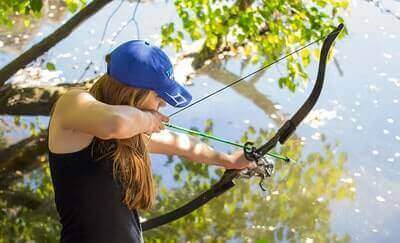Disclosure: We may earn commissions if you purchase products after clicking on a link from our site.
Do you want to learn how to bowfish? Bowfishing is a fun and exciting sport that can be enjoyed by people of all ages. In this guide, we will teach you everything you need to know about how to bowfish.
We will cover the basics concerning how to bowfish such as how to choose the right equipment and how to set up your shot. We will also discuss some of the best techniques for bow fishing, including how to spot fish in shallow water and how to shoot them accurately.
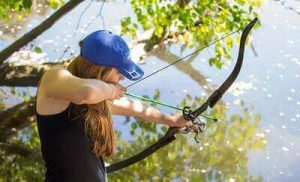
Table of Contents
Bowfishing Equipment
1. Bow
Several different types of bows can be used for bow fishing, including recurve bows, compound bows, and crossbows. However, it doesn’t need to be an expensive one. If you are just starting with bow fishing, a used one from a pawn shop or family or friends with a good string will be ok. One with a draw weight of 25 to 50 pounds will serve you well. You can read a review of the best recurve bows from this link.
2. Reel
When it comes to bow fishing, selecting the right reel is essential for effectively landing fish after a successful shot. Bow fishing reels are specifically designed to attach to the bow and accommodate the unique demands of this sport.
One of the most common types of reels used in bow fishing is the spin-cast reel, also known as the closed-face reel. These reels feature a push-button mechanism for easy operation and are mounted directly onto the bow’s riser.
Another popular option is the retriever reel, which utilizes a hand-crank mechanism to retrieve the line after shooting. Retriever reels are favored for their quick line retrieval, making them ideal for targeting fast-moving fish like carp or gar.
Regardless of the type, bow fishing reels are typically equipped with heavy-duty fishing lines, often made from braided nylon or Dacron, to withstand the rigors of hauling in large and powerful fish.
Additionally, many bow fishing reels are designed with a line attachment point or bottle reel to securely hold the line while aiming and shooting. Overall, choosing the right reel is crucial for maximizing success and enjoyment in the exhilarating sport of bow fishing. There are three types of reels: the hand reel, the bottle, and the spin cast reel.
A. Hand Reel
The hand reel is the most basic of the reels. It consists of a drum with a line spool around it. It is simple to use and most affordable. It has no breakable parts. After shooting your arrow, you roll the line around the drum as you pull. The hand reel, however, requires heavier lines and a lot of manual labor.
B. Bottle Reel
The bottle reel features a bottle that has a line and a handle. It is reliable and the most popular reel. Bottle reels usually use heavy lines and you won’t encounter a problem pulling in the line. However, accurate long shots may be a challenge.
C. Spincast Reel
The spincast reel is a reel mounted on a bow. You can retrieve the line faster than any other reel with the spincast reel. Spincast reels feature thin lines and this allows you to take long shots with more accuracy. Spincast reels pose a challenge to clean and maintain. They are also not the cheapest reels.
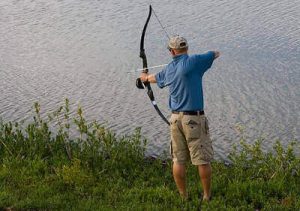
3. Arrows
In bow fishing, arrows play a crucial role as the primary tool for targeting and retrieving fish. Bow fishing arrows, also known as “bowfishing bolts” or simply “shafts,” are specifically designed to withstand the forces encountered when shooting into water and retrieving fish.
These arrows are typically heavier and sturdier than traditional archery arrows, with a solid fiberglass or carbon fiber construction that provides durability and strength. At the front end of the arrow, a specialized arrowhead is attached, often featuring barbs or prongs to securely penetrate and hold onto fish upon impact.
This design prevents fish from easily escaping after being shot, allowing anglers to reel them in more effectively. Bow fishing arrows also feature a nock or notch at the back end, allowing them to be securely attached to the bowstring.
Additionally, many bow fishing arrows are equipped with brightly colored fletchings or vanes, which aid in visibility and tracking underwater. Overall, bow fishing arrows are essential gear for any bow fisherman, providing the means to accurately target and harvest fish while enjoying the thrill of this unique and exciting sport.
4. Arrow Rest
An arrow rest is a vital component of bow fishing gear, serving as the platform from which the arrow is launched. In bow fishing, where precision and accuracy are crucial, the arrow rest plays a significant role in ensuring a smooth and consistent arrow release.
Unlike traditional archery, where arrow rests may vary in design and function, bow fishing arrow rests are typically simple and rugged, designed to withstand the rigors of shooting in water environments.
Common types of arrow rests used in bow fishing include roller rests, brush rests, and containment rests. Roller rests feature a rotating roller that reduces friction as the arrow passes over, promoting a smooth release. Brush rests utilize bristles or fibers to support the arrow, providing minimal contact and reducing the chance of interference during the shot.
Containment rests securely hold the arrow in place until the shot is released, preventing accidental arrow displacement. Regardless of the specific type, a well-chosen arrow rest ensures stability and consistency, allowing bow fishermen to focus on their target and make accurate shots while enjoying the excitement of bow fishing.
5. Polarized Sunglasses
Polarized sunglasses are indispensable fishing gear for bow fishing enthusiasts, offering essential protection and enhanced visibility on the water. Specifically designed to reduce glare and improve clarity, polarized sunglasses help bow fishermen see through the water’s surface, allowing them to spot fish and potential obstacles with ease.
By filtering out reflected light and minimizing eye strain, polarized lenses enable anglers to focus on their target and make accurate shots, even in bright sunlight or challenging lighting conditions.
Additionally, polarized sunglasses provide crucial eye protection from harmful UV rays and flying debris, ensuring a safe and comfortable fishing experience. With their ability to enhance visibility and reduce glare, polarized sunglasses are an essential accessory for bow fishermen seeking success on the water.
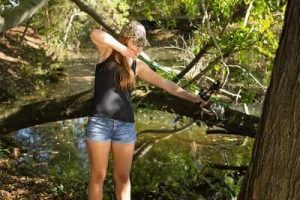
6. Lights
Lights are essential fishing gear for bow fishing enthusiasts, especially during nighttime expeditions or low-light conditions. Bow fishing lights come in various forms, including LED lights, halogen lights, and HID lights, and they are typically mounted on the bow or boat to illuminate the surrounding waters.
These lights serve multiple purposes: they attract fish by creating a visible source of light underwater, they enhance visibility for the archer by illuminating the target area, and they ensure safety by allowing bow fishermen to navigate effectively in the dark.
LED lights, in particular, are popular for their energy efficiency, long lifespan, and bright illumination, making them an ideal choice for bow fishing outings. Whether casting from the shore or cruising on a boat, lights play a crucial role in enhancing visibility and increasing the chances of a successful bow fishing trip.
7. Waders
While waders are not commonly associated with bow fishing compared to traditional angling, they can still be useful fishing gear for certain bow fishing situations, particularly in shallow or marshy areas where access to the water is limited. Waders are waterproof boots or trousers designed to keep anglers dry while wading into water bodies.
In bow fishing, wearing waders allows fishermen to wade into shallow waters, providing better positioning and visibility to target fish. This is especially advantageous when hunting for species like carp or gar, which often inhabit shallower areas near the shoreline.
Additionally, waders offer protection from mud, rocks, and sharp objects on the water’s bottom, enhancing comfort and safety during bow fishing expeditions. While not essential for all bow fishing scenarios, having a pair of durable and waterproof waders can significantly improve mobility and accessibility in certain fishing environments.
8. Bug spray
Bug spray is a crucial fishing gear accessory for bow fishing, especially during warmer months and in regions where insects are prevalent. Bow fishermen often spend long hours near water bodies or in marshy areas where mosquitoes, flies, and other insects can be bothersome and potentially distracting.
Applying bug spray helps to repel insects, minimizing the risk of bites and discomfort, thus allowing anglers to focus more effectively on their bow fishing pursuits.
Additionally, insect repellents with DEET or other active ingredients can provide protection against disease-carrying insects, reducing the likelihood of contracting mosquito-borne illnesses such as West Nile virus or Zika virus. By keeping insects at bay, bug spray ensures a more enjoyable and focused bow fishing experience, enabling anglers to concentrate on aiming and targeting their prey without distraction.
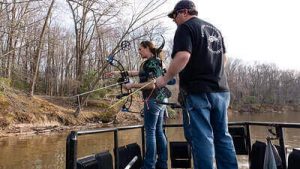
Types of Fish For Bowfishing
1. Carp – Common, Bighead, Silver, Grass
Carp, known for their large size and tendency to inhabit shallow freshwater environments, are a popular target for bowfishing enthusiasts. With their broad bodies and distinctive scales, carp are easily identifiable targets for bowfishers seeking a challenging and rewarding pursuit.
Bowfishing for carp typically involves stalking these fish in shallow waters such as lakes, rivers, and ponds, where they often congregate in schools. Armed with specialized bows equipped with powerful reels and barbed arrows, bow fishers aim for carp cruising near the water’s surface or lurking in the shallows.
The stealthy approach and quick reflexes required for bow fishing make it an exhilarating sport, demanding both precision and patience from participants. As an invasive species in some regions, targeting carp through bow fishing also serves a conservation purpose by helping to control their populations and preserve native aquatic ecosystems. Overall, carp present bow fishers with an exciting and challenging opportunity to test their skills and enjoy the thrill of hunting fish in a unique and immersive way.
2. Gar – Longnose, Shortnose, Spotted, Alligator
Gar, with their prehistoric appearance and formidable size, is a prime target for bowfishers seeking an adrenaline-filled adventure. Found in freshwater habitats across North America, including rivers, lakes, and bayous, these ancient fish are easily recognizable by their long, slender bodies and sharp-toothed snouts.
Bowfishing for gar requires stealth and precision, as these elusive creatures often lurk near the water’s surface or hide among submerged vegetation. Armed with specialized bows equipped with heavy-duty reels and sturdy arrows, bow fishers aim gar as they glide through the murky depths or bask in the shallows. The challenge of landing a gar with a bow adds an extra layer of excitement to the sport, requiring sharp reflexes and keen eyesight to hit a moving target with accuracy.
Additionally, bow fishing for gar serves a practical purpose in some regions, helping to manage their populations and protect native fish species. Overall, pursuing gar through bow fishing offers enthusiasts an exhilarating outdoor experience that combines the thrill of hunting with the excitement of fishing.
3. Buffalo – Bigmouth, Smallmouth
Buffalo fish, known for their impressive size and powerful swimming abilities, are a popular target for bow fishers seeking an exciting challenge on freshwater adventures. Found in rivers, lakes, and reservoirs across the United States, these robust fish can grow to substantial lengths, making them formidable opponents for bowfishers aiming to land a trophy catch.
With their distinctive humped backs and large scales, buffalo fish are easily recognizable underwater, often congregating in schools near the surface or along the edges of submerged structures. Bowfishers armed with specialized equipment, including compound bows fitted with sturdy reels and barbed arrows, aim for buffalo fish as they cruise through the water or feed on aquatic vegetation.
The thrill of the hunt combined with the raw power of buffalo fish creates an exhilarating experience for bowfishers, who must demonstrate accuracy and agility to successfully bring in these heavyweight adversaries.
Additionally, bow fishing for buffalo fish contributes to conservation efforts by helping to manage their populations and maintain healthy aquatic ecosystems. Overall, targeting buffalo fish through bow fishing offers enthusiasts an adrenaline-fueled pursuit that showcases the thrill of outdoor sportsmanship.
4. Freshwater Drum
The freshwater drum, also known as sheepshead, gaspergou, or grunter, presents an intriguing opportunity for bowfishers seeking an exciting challenge in freshwater environments. These resilient fish are widespread across North America, inhabiting rivers, lakes, and reservoirs with their characteristic cylindrical bodies and distinctive blunt heads.
Renowned for their voracious appetite and robust fighting spirit, freshwater drum often congregate in schools near underwater structures or along rocky shorelines, making them prime targets for bowfishers looking to test their skills.
Armed with specialized bow fishing equipment, including powerful bows equipped with reels and barbed arrows, anglers aim freshwater drum as they navigate the shallows or feed on bottom-dwelling prey. Successfully landing a freshwater drum requires precision, patience, and quick reflexes, as these formidable fish can put up a spirited resistance when hooked.
Furthermore, bow fishing for freshwater drum contributes to sustainable fisheries management by helping to control their populations and maintain ecological balance in freshwater ecosystems. Overall, pursuing freshwater drum through bow fishing offers anglers an exhilarating and rewarding outdoor adventure that celebrates the thrill of the chase and the beauty of nature’s bounty.
5. Catfish
Bowfishing for catfish presents a thrilling opportunity for anglers to target these formidable freshwater predators in a unique and exhilarating way. Known for their tenacity and powerful strikes, catfish are a prized catch among bowfishers seeking a challenging pursuit. Found in rivers, lakes, and reservoirs throughout North America, catfish inhabit a variety of aquatic environments, from murky backwaters to deep channels.
Using specialized bow fishing gear equipped with high-powered bows and barbed arrows, anglers aim catfish as they patrol the shallows or lurk near underwater structures. Successfully landing a catfish requires skillful shooting and precise aim, as these crafty fish can quickly evade capture with their lightning-fast reflexes and sharp senses.
Moreover, bow fishing for catfish contributes to sustainable fisheries management by helping to control their populations and maintain ecological balance in freshwater ecosystems. Overall, targeting catfish through bow fishing offers anglers an adrenaline-fueled adventure that combines the thrill of the hunt with the satisfaction of reeling in a prized trophy fish.
6. Tilapia
Bowfishing for tilapia offers a unique and rewarding angling experience, blending the excitement of bowhunting with the challenge of fishing. Tilapia, known for their voracious feeding habits and widespread distribution in freshwater environments, make for enticing targets for bowfishers seeking a thrilling pursuit.
These resilient fish inhabit various aquatic habitats, including lakes, ponds, rivers, and even brackish waters, making them accessible to bowfishers across a wide range of geographic regions. Armed with specialized bow fishing equipment, anglers can stalk tilapia along shallow shorelines, near submerged vegetation, or around underwater structures.
Precision shooting and keen observation are crucial when targeting tilapia, as these fish are known for their skittish behavior and quick darting movements. Successfully landing a tilapia with a well-aimed arrow provides bowfishers with a sense of accomplishment and satisfaction, as they harvest a delicious and sustainable freshwater delicacy.
Moreover, bow fishing for tilapia contributes to fisheries management efforts by helping to control their populations and mitigate their impacts on native aquatic ecosystems. Overall, pursuing tilapia through bow fishing offers anglers an exhilarating adventure that combines the thrill of the hunt with the enjoyment of reaping the rewards of a successful catch.
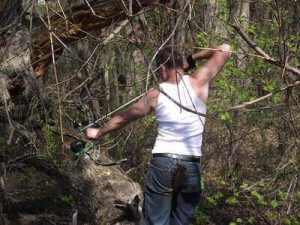
How To Bowfish
1. Know your state’s law. You might need a fishing license or a hunting one might be what you need. You can read this article on 30 hunting items every hunter needs.
2. Bowfishers have to judge the distance from the fish, the light refraction, and the fish’s depth. When you are learning how to bowfish, this is very important.
3. Due to refraction, you want to be 10-15 feet away from the fish when you shoot. Aim at about six inches below the fish to compensate for the water’s refraction. If it is a big fish, aim for its belly to hit it.
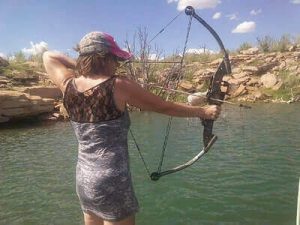
4. Don’t aim directly at the fish. You will most likely miss it. Always aim low because of refraction. When learning how to bowfish, this may seem strange when introduced to you, but if you remember refraction from your high school Physics class, then it will all make sense.
5. Dams and overflows are good places to bowfish, especially during the spawn.
6. After taking many shots and with experience, you will not have to think about aiming lower as it will come instinctively.
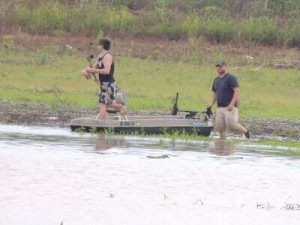
7. A hat, polarized sunglasses, and suntan lotion will help if you bowfish during the day. At night, you will need lights and bug spray.
8. Sharpen your shooting skills by taking practice shots with some object or a leaf under the water. This will help you to adjust your shot.
9. Start bow fishing with a body of water that you are familiar with. When you hone your skills and gain experience, you can choose a lake or river that you are familiar with especially if you will bowfish at night.
10. It is good to know where the shallow parts of the river are, the clumps of vegetation, and where the fastest currents run. You can do some research with Google Earth to identify possible locations of these areas.
11. Many bowfishers believe that the best time to bowfish is the spawn. During this time, the fish are easily seen, they are in the reedy shallows and distracted.
12. In the Spring, carp are usually in weedy and shallow areas. Additionally, areas with stumps, reeds, and brushes are also good places to bowfish.
13. Shallow rocky rivers in the spring can reveal a treasure trove of carp.
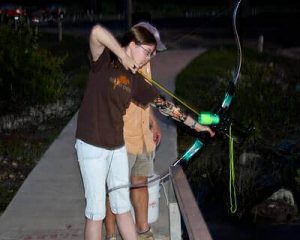
How To Bowfish For Carp
Carp can be found in most of the United States with the Gulf States being popular bowfishing locations. You can find them in freshwater lakes, rivers, reservoirs, and ponds. They can be found around reed beds, lilies, and other structures early in the morning and late evening.
The best time of the year to go bowfishing is the summer and fall months from April to October. You will use a bow and arrow at close range when bowfishing for carp. Most of the waters that you will be bowfishing in will be shallow and clear.
For successful bowfishing, you will need the right bowfishing gear. There are complete bowfishing packages that you can get from stores. The main gear for bowfishing includes a bow, arrow, reel, and arrow stabilizer. Recurve or compound bows work well when bowfishing.
Use arrows made specifically for bowfishing; don’t use hunting or archery arrows. For reels, there is the hand reel, the bottle reel, and the spincast reel. The spincast reel is popular for its accuracy and its ability to quickly retrieve the lines.
When bowfishing, you just need to be careful and not make a lot of noise to alert the fish. Secondly, you need to take good aim. Most of the time the water will be clear and shallow which will help you when aiming.
Refraction is a major factor when bowfishing since light waves refract when they hit the water. Therefore you will have to aim slightly below the fish to hit it. Many bowfishermen recommend aiming about 6 inches beneath the fish and then following the 10-4 rule.
This rule states that to hit a fish that is a foot below the water, aim 4 inches underneath it, then add an extra 4 inches for every 10 feet in the distance you travel.
How To Bowfish At Night
Many bow fishermen prefer bowfishing at night. Scouting the area during the day will improve your chances of success at night. it will help you understand the area you want to target at night. use Google Maps or fishing apps to also help you scout and mark areas you want to focus on during the night.
Determine which type of fish you want to target when bowfishing at night and look for areas and signs of it. Get the right gear for bowfishing. The right bow, arrow, reel, and arrow stabilizer are very important. Ultimately, you want a bow that can draw back quickly and shoot fast. You will also need very good lighting when bowfishing at night. There are many options with LED lighting being one of them.
Bowfishing comes down to spotting your target and taking a good shot to hit it. It is not complicated and the more you bowfish, the better you will become. Refraction plays an important part when it comes to hitting fish in the water. You will have to aim slightly below the fish to hit it.
How To Bowfish From Shore
Bowfishing from the shore involves finding areas that give you access to shallow and clear waters. When you arrive at the shore, spend some time studying the water and the shoreline. Calm waters give you a good opportunity to bowfish. Look for areas that are clear and shallow. Look for areas that show signs of marine life. See if you can spot fish moving through the water.
Additionally, learn to walk lightly and don’t make a lot of noise when you walk along the shore. Try as much as possible to keep your shadow from the water. Most fish will be close to structures to use as cover for protection and concealment when ambushing their prey. Broken-down docks, piers, and fallen trees are some of the structures that fish will hang around.
When you find good spots, take a position and carefully watch and wait for fish to come closer. When they do, aim and take a good shot. You will be successful more times than not. And always take refraction into account when shooting in the water.
How To Bowfish For Catfish
Catfish are not often found in shallow waters. But when they do, you can bowfish for them. Most of the time, you will be bowfishing for carp when you spot catfish. When you see catfish, aim with your bow. Refraction has to be taken into account and the fish won’t be exactly where your naked eyes see it. You will have to shoot slightly underneath it to hit the catfish.
How To Bowfish Muddy Water
Bowfishing is usually done in shallow, clear, and calm waters. Therefore, when the water is muddy, it presents a challenge for the bow fishermen. However, there are tricks that you can apply to bowfish in muddy water.
When the water is muddy, look for backwater areas where there may be flooded timber or crop fields. A backwater with the same continuous water flows that made the water muddy. You can also look for pinch points where you can find fish swimming.
Additionally, look for shallow areas with big rocks where carp and other fish may be hanging out in ambush of their prey. Target those areas. Bowfishing at night is another option when the water is muddy and you can use lights to help see in the water.
You can also wait for them to spawn as this will happen in shallow waters or near banks. Since they will be spawning, there will be many of them in the area making it easier to target them. You can also use chumming if it is legal in your area. You can drop pieces of bait into the water to attract them and create a trail closer to you in the shallow water.
How To Bowfish For Beginners
Bowfishing is a fun and effective way of fishing. To get into bowfishing as a beginner, you will need the right gear. A bow and arrow, a reel, and an arrow stabilizer are the essential gear. Some archery practice to improve your aiming will help improve your chances of landing the fish.
Next, you may want to go back to high school physics and refresh your memory about refraction. When light waves hit the water, they refract. This means the fish will not be exactly where you see it. You will have to aim slightly underneath it to hit it.
When bowfishing, study the water and look for structures that may be protruding out of the water. Poles, damaged docks, piers, fallen trees, and logs are some of the structures that fish will be around as they seek cover when ambushing prey. Look for big rocks in shallow waters as fish will also be near them trying to ambush prey.
Additionally, learn to walk lightly on the shores when bowfishing and avoid making a lot of noise. Wear dark-colored clothes to keep yourself concealed.
Learn the fishing rules for your state. Sometimes the fish may be hard to spot and if it is legal in your state, you can chum to get fish out of their hiding areas and closer to you. Learn when the fish in your area spawn as they will come into shallow waters when spawning and there will be many of them in the area.
Bowfishing Safety Tips
1. Have a safety slide installed on all of your arrows to prevent tangles, especially if you are a beginner.
2. Be attentive and watch out for your line tangling or sliding around the bow.
3. The bow fishing line should never be tied directly to the back end of your arrow.
4. If you are in a boat, wear your life jacket at all times.
5. Be familiar with the areas you will be bow fishing in. Research on Google Earth can help.
6. Don’t fish in areas that are not permitted for bow fishing.
7. Monitor the local weather for the area you want to bow fish in before going out.
8. Have safety gear with you at all times.
9. Have a first aid kit with you.
10. Take along a waterproof flashlight, maps, flares, and a horn, or whistle.
11. Make sure your cell phone is charged and take a solar charger if possible.
12. Wear hip waders and waterproof boots if you will only bowfish the shallow areas.
13. Step with caution and be mindful of the depth of the water you are wading in.
14. Inform someone where you will be going to bow fish. Inform them of your departure and return times.
15. Take enough snacks and bottles of water.
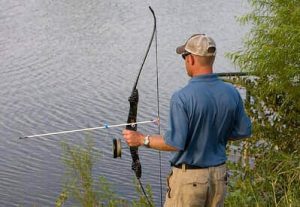
Safety Gear Checklist
1. Life Jackets
Life jackets serve as essential safety gear when bowfishing, providing crucial protection for anglers venturing onto the water. Whether wading in shallow rivers or fishing from a boat, wearing a properly fitted life jacket significantly reduces the risk of accidents and drowning incidents.
In the dynamic environment of bowfishing, where shifting currents, unexpected obstacles, and sudden movements can occur, a life jacket offers buoyancy and flotation to keep anglers afloat in case of an accidental fall or immersion.
Additionally, life jackets provide insulation against cold water and can help conserve energy, allowing bowfishers to remain safe and afloat until rescue arrives. Even strong swimmers can benefit from wearing a life jacket, as it provides an added layer of security and peace of mind, especially in challenging conditions or unfamiliar waters. Prioritizing safety by wearing a life jacket ensures that bowfishers can focus on enjoying their angling experience while minimizing the risk of water-related accidents and injuries.
2. First Aid Kit
A first aid kit is an indispensable safety accessory for bowfishers, offering essential supplies to address minor injuries and medical emergencies that may occur during outings. Stocked with items like bandages, antiseptic wipes, gauze pads, adhesive tape, scissors, and tweezers, a well-equipped first aid kit enables bowfishers to promptly treat cuts, scrapes, and insect bites encountered while navigating through rugged terrain or handling fishing equipment.
Additionally, items such as pain relievers, antihistamines, and blister treatment aids can alleviate discomfort and allergic reactions, ensuring that anglers can quickly address common health issues and continue enjoying their bowfishing adventure.
Moreover, including emergency contact information, medical history forms, and instructions for administering first aid can enhance preparedness and facilitate efficient response to more serious injuries or medical incidents. Carrying a compact, waterproof first aid kit ensures that bowfishers can effectively manage unexpected health concerns and maintain safety while immersed in the dynamic outdoor environment.
3. Maps
Maps serve as essential safety items for bowfishers, providing valuable information about water bodies, potential hazards, and navigational routes. By carrying detailed maps of the fishing area, bowfishers can familiarize themselves with the terrain, including shallow waters, submerged obstacles, and navigational markers, which helps prevent accidental collisions and grounding.
Additionally, maps highlight access points, boat ramps, and designated fishing areas, enabling bowfishers to plan their routes effectively and locate suitable spots for targeting fish species. In unfamiliar or remote locations, maps offer vital guidance in case of emergencies, allowing bowfishers to identify nearby landmarks, roads, and emergency services for swift assistance.
Moreover, digital mapping tools and GPS devices enhance navigational accuracy and real-time location tracking, providing an added layer of safety for bowfishers exploring unfamiliar waters. By incorporating maps into their safety gear, bowfishers can navigate confidently, mitigate risks, and enjoy a safer and more rewarding bowfishing experience.
4. Compass
A compass is an indispensable safety item for bowfishers, especially when navigating unfamiliar or remote waters. While modern GPS devices and electronic navigation tools are prevalent, a compass serves as a reliable backup in case of technological failures or battery depletion.
Bowfishers can use a compass to orient themselves and determine their direction of travel, allowing them to navigate with confidence even in challenging conditions such as fog, darkness, or limited visibility. In addition to providing directional guidance, a compass can help bowfishers maintain a sense of spatial awareness and track their movements relative to landmarks or known reference points.
By including a compass in their safety gear, bowfishers can enhance their preparedness, mitigate the risk of getting lost or disoriented, and ensure a safer and more enjoyable bowfishing excursion.
5. Waterproof Flashlight
A waterproof flashlight is an essential safety item for bow fishing excursions, particularly for those heading out during low-light conditions or at night. Whether navigating through dense vegetation, scanning the water’s surface for movement, or illuminating potential hazards, a reliable waterproof flashlight ensures visibility and enhances situational awareness.
In the event of an emergency or unexpected situation, such as a boat malfunction or an injury, a waterproof flashlight can serve as a beacon for signaling for help or attracting attention. Moreover, its waterproof construction ensures functionality even if it accidentally falls into the water, providing peace of mind and reliability in challenging environments.
By including a waterproof flashlight in their safety gear, bowfishers can effectively mitigate risks, enhance their ability to navigate and communicate and ensure a safer and more prepared bowfishing experience.
6. Flares
Flares serve as indispensable safety items to carry along when bow fishing, especially during outings in remote or isolated areas. In case of an emergency, such as becoming lost or stranded, flares provide a visible and attention-grabbing distress signal. The bright light emitted by flares is easily recognizable from a distance, alerting nearby boaters, rescuers, or passing vessels to the location of individuals in need of assistance.
Furthermore, flares are effective tools for signaling distress during low-light conditions or at night, when visibility may be limited. By including flares in their safety gear, bow fishers can significantly increase their chances of being located and rescued swiftly in emergencies, thereby enhancing overall safety and preparedness during bow fishing expeditions.
7. Whistle or Horn
A whistle or horn is an essential safety item to have when bow fishing, providing a reliable means of signaling for help in emergencies. Compact and lightweight, a whistle can easily be attached to a life jacket or carried on a lanyard for quick access.
In the event of an accident, such as falling overboard or encountering a dangerous situation, blowing a whistle produces a loud, distinct sound that can alert nearby boaters or fellow anglers to the need for assistance.
Additionally, a whistle’s piercing sound carries over long distances and is audible even in adverse weather conditions or when other communication methods may be ineffective. By including a whistle in their safety gear, bow fishers can ensure they have a simple yet effective tool for summoning help and enhancing their safety while out on the water.
8. Snacks
Carrying snacks while bow fishing is not only a matter of convenience but also an important safety consideration. Spending long hours on the water can deplete energy levels, leading to fatigue and decreased alertness, which can compromise safety. Having easily accessible snacks like energy bars, trail mix, or fruit provides a quick source of nourishment to maintain energy levels and mental focus throughout the day.
Moreover, unexpected delays or adverse weather conditions may prolong the time spent on the water, making snacks essential for sustaining energy until returning to shore. By ensuring adequate sustenance is readily available, bow fishers can enhance their overall safety and enjoyment of the fishing experience.
9. Bottles of Water
Bringing along bottles of water is a crucial safety measure when engaging in bow fishing. Staying hydrated is essential for maintaining physical performance and cognitive function, especially during extended periods spent outdoors in potentially hot or humid conditions.
Dehydration can lead to fatigue, dizziness, and impaired decision-making, all of which pose risks while navigating water bodies or handling bow fishing equipment. Having access to ample water ensures that bow fishers can replenish lost fluids throughout the day, helping to prevent dehydration and its associated negative effects.
Additionally, water bottles serve as a vital resource in case of emergencies, providing hydration for extended waits or unexpected delays until assistance can arrive. Therefore, carrying water bottles is not only a safety precaution but also a fundamental aspect of responsible bow fishing.
10. Cell Phone & Solar Charger
Carrying a cell phone and a solar charger while bow fishing can significantly enhance safety and preparedness on the water. A cell phone serves as a lifeline for communication in case of emergencies, allowing bow fishers to call for help or alert authorities if they encounter unforeseen challenges or accidents.
With access to cellular networks, individuals can quickly summon assistance and provide accurate information about their location, expediting rescue efforts if necessary. Additionally, a solar charger ensures that the cell phone remains powered throughout the excursion, even in remote areas where electrical outlets are unavailable.
By harnessing solar energy to recharge the phone’s battery, bow fishers can maintain communication capabilities for extended periods, providing peace of mind and enabling swift responses to any safety concerns that may arise. Thus, incorporating a cell phone and solar charger into the bow fishing gear ensures that anglers are adequately equipped to handle emergencies and stay connected while enjoying their outdoor pursuits.
11. Hat
Wearing a hat while bow fishing serves as an essential safety item to protect against various outdoor elements and enhance overall comfort during the excursion. A hat with a wide brim shields the face, neck, and eyes from the sun’s harmful UV rays, reducing the risk of sunburn and minimizing the chances of heat-related illnesses such as heatstroke or sunstroke.
Additionally, a hat provides valuable shade, helping to keep the head cool and prevent overheating during prolonged periods spent under the sun. In addition to sun protection, a hat can also offer protection against rain, wind, and flying insects, further enhancing the angler’s comfort and safety while on the water.
Furthermore, certain hats feature reflective elements or bright colors, increasing visibility in low-light conditions or emergencies, thereby facilitating easier identification and rescue if needed. Overall, wearing a hat is a simple yet effective safety measure that ensures bow fishers remain protected and comfortable throughout their outdoor adventures.
12. Sunscreen
Sunscreen is an indispensable safety item for bow fishers, providing crucial protection against the sun’s harmful ultraviolet (UV) rays during extended periods spent outdoors. Applying sunscreen to exposed skin areas, such as the face, neck, arms, and legs, helps prevent sunburn and premature aging, and reduces the risk of developing skin cancer.
Bow fishing often involves being exposed to direct sunlight for hours at a time, increasing the susceptibility to sun damage. Therefore, choosing a broad-spectrum sunscreen with a high sun protection factor (SPF) and water-resistant properties is essential to ensure long-lasting protection, even in wet conditions.
Reapplying sunscreen every couple of hours, especially after swimming or sweating, maintains its effectiveness and minimizes the risk of sunburn and skin damage. By incorporating sunscreen into their safety gear, bow fishers can enjoy their outdoor adventures comfortably while safeguarding their skin against the harmful effects of UV radiation.
13. Polarized Sunglasses
Polarized sunglasses are an essential safety item for bow fishing enthusiasts, offering vital protection for the eyes against glare and harmful UV rays while out on the water. The polarized lenses effectively reduce glare caused by sunlight reflecting off the water’s surface, allowing bow fishers to see beneath the surface with enhanced clarity and visibility. This improved visibility is invaluable when targeting fish, as it helps detect their movements and locate potential catch spots more easily.
Additionally, polarized sunglasses provide crucial eye protection by filtering out harmful UV rays, reducing the risk of eye strain, fatigue, and long-term damage from sun exposure. By wearing polarized sunglasses as part of their safety gear, bow fishers can enjoy a more comfortable and productive fishing experience while safeguarding their vision against the sun’s harsh glare and UV radiation.
14. Rainwear
Rainwear is a vital safety item for bow fishing excursions, protecting against inclement weather conditions such as rain and wind. When out on the water, sudden rain showers or storms can pose significant challenges and discomforts for bow fishers.
Therefore, having waterproof and wind-resistant rainwear ensures that anglers stay dry and comfortable throughout their fishing trip, allowing them to focus on their activity without being hindered by wet clothes or exposure to cold temperatures.
Additionally, rainwear with reflective elements enhances visibility, making it easier for other boaters to spot bow fishers in adverse weather conditions, thereby reducing the risk of accidents or collisions. By including rainwear in their safety gear arsenal, bow fishers can effectively mitigate the impact of unpredictable weather and maintain their safety and comfort while pursuing their passion for fishing.
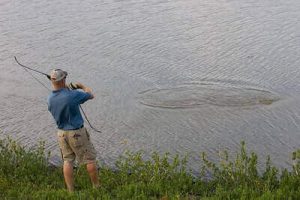
The Bottom Line
How to bowfish is not as difficult to learn as it seems. Bowfishing is an exciting outdoor activity that continues to gain popularity. In this article, we discussed how to bow fish, the basic equipment you need, some of the popular fish bow fishermen go after, safety, and other bow fishing-related topics.
We hope that these bowfishing tips will help you be successful at bow fishing. You can learn how to fish a pond by reading this article from this link.
